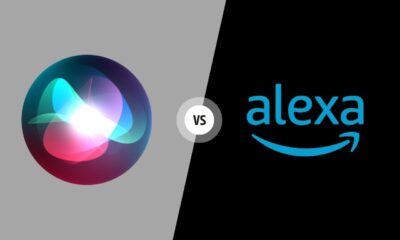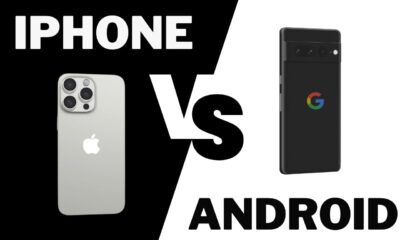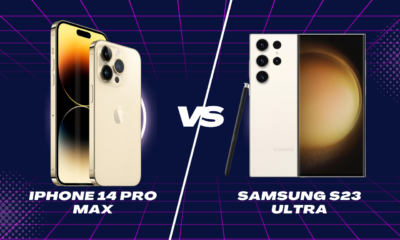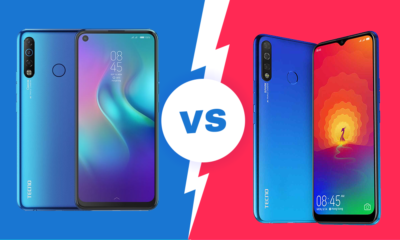Featured
Mediatek vs Snapdragon? Which one should you prefer and Why? Unbox Cell

Huawei and Samsung are two of the only Android makers consistently creating in-house processors. Every other person turns to Qualcomm and MediaTek for their mobile chip needs. The two organizations have been the overwhelming third-party chipset suppliers for quite a long while now, following the withdrawal of players like Texas Instruments, Intel, and ST-Ericsson’s NovaThor. We’ve assembled a helpful introduction on the mediaTek vs snapdragon, covering their disparities and reasons why a company would pick either.
Mediatek Helio p60 vs snapdragon 660
MediaTek Helio P60 has been working with a 12 nm production process, that is superior to the 14 nm generation procedure of the Snapdragon 660.
Whereas, Snapdragon 660 has a greater clock frequency and an Adreno 512 GPU, which I define superior to the Mali G72 MP3 found on its rival. Thus, the Snapdragon 660 may have better performance both in using daily and gaming. The Snapdragon 660 has a marginally better modem too (Cat. 13 versus Cat. 7 DL), and the battery charging is quicker thanks to the Quick Charge 4.0.
In any case, the MediaTek Helio P60 has a progressed dedicated module for AI, which can perform profound learning facial location, scene recognition, AR and MR increasing speed, and progressively brilliant tasks: it is called NeuroPilot.
Pro and Cons: MediaTek Helio P60

PRO
- Better generation process
- AI
- Increasingly reasonable cost
- Low energy utilization
CONS
- Conceivably more awful performance
Pro and Cons: Qualcomm Snapdragon 660

PRO
- Possibly better performance
- Better GPU
- More reasonable for modding
- Power-effective
CONS
- No AI
Mediatek helio p70 vs snapdragon 660
Performance:
MediaTek has utilized TSMC’s 12nm FinFET generation process for the Helio P70.
On the CPU end, this octa-center processor packs four ARM Cortex A73 cores going about as the presentation cores and four ARM Cortex A53 cores going about as the proficiency cores.
On the off chance that you review, Helio P60 conveys a similar arrangement, however its performance cores are timed at 2.0GHz. MediaTek claims that this adjustment in timing, frequency denotes a 13% expansion in overall performance.
This arrangement is combined with a Mali G72 GPU, which sees a bump in clocking recurrence to 900MHz. In the CPU division, the P70 gives off an impression of being like the P60, safe for the clocking recurrence. Additionally, MediaTek has adhered to the regular cores arrangement.
Camera:
With regards to the camera, the Helio P70 sports indistinguishable specs from the Helio P60, which implies that the triple picture signal processor returns. The P70 can support up to a 24MP + 16MP double camera cluster.
In addition, MediaTek likewise presented a high-resolution depth motor to upgrade portraits. It’s significant that this chipset brings AI facial discovery, ongoing HDR capture, and a quicker shooting mode.
Curiously, Qualcomm has launched the couple of Qualcomm Clear Sight and Spectra 160 ISP chip. Both of these join to give more light and less noise, and the Spectra 160 ISP chip gets quicker autofocus, exact color propagation alongside zero shutter lag.
Artificial Intelligence:
The Helio P70 takes after the P60 with regards to AI. It packs a devoted multi-core Artificial Intelligence Processing Unit (AMU), which will discover use in posture detection, programmed scene recognition, object identification, and facial recognizing. This APU joins with the MediaTek NeuroPilot to convey 10-30% more AI preparing efficiency contrasted with its ancestor.
Mediatek helio p20 vs snapdragon 450
Helio P20 (LP4) MT6757:

The Mediatek Helio P20 MT6757 is an upper standard ARM SoC for smartphones (for the most part Android based) that was presented in 2016. It is fabricated in a 16 nm FinFET process and is outfitted with 8 ARM Cortex-A53 CPU centers timed at 2.3 GHz (max.). The chip likewise incorporates a LTE modem (Cat. 6).
The coordinated ARM Mali T880 MP2 GPU is timed at up to 900 MHz and has two group (from 16) from the Midgard (fourth Gen) architecture.
Snapdragon 450:

The Qualcomm Snapdragon 450 (SD450) is a lower standard SoC for (Android based) smartphones and tablets. It highlights eight ARM Cortex-A53 cores at up to 1.8 GHz and is as of now fabricated in the power productive 14nm procedure. The coordinated X9 LTE modem supports Cat. 7 with greatest transfer rates of 300 Mbps (downstream) and 150 Mbps (upstream). The SoC additionally incorporates an Adreno 506 GPU with help for Vulkan and OpenGL ES 3.1. WiFi 802.11ac (1×1, max 364 Mbps) and Bluetooth 4.1 are also supported. The memory controller bolsters LPDDR3 (single channel) and the incorporated video engine supports H.264 (encode and unravel) and HEVC (just decode) in 1080p.
Mediatek helio p65 vs snapdragon 675
CPU and GPU:

Beginning with CPU, the MediaTek Helio P65 chipset has an octa-core CPU and deals with 64-bit framework. It has blend of 2 + 6 centers. It offers 2 ARM Cortex A75 centers that works in overwhelming tasks while other 6 Cortex-A55 centers to taking care of normal tasks.
On opposite side discussing Snapdragon 675 chipset, it is additionally a 64-bit octa-core chipset. It has Kryo 460 CPU implies it has 2 Cortex-A76 gold cores timed at up to 2.0GHz greatest clock speed while other 6 Cortex-A55 silver cores work with a most extreme speed of up to 1.8GHz.
Camera support:

Talking about Optics, the MediaTek Helio P65 can support a solitary camera of up to 48MP, this is the reason in light of the fact that each manufacture is attempting to give better as better camera sensor in its cell phone like 48MP sensor.
On opposite side, discussing Qualcomm Snapdragon 675, it supports up to 25MP single camera and a double camera of up to 16MP. The company guarantees this chipset can catch pictures up to 48MP, and the smartphones like Redmi Note 7 Pro are demonstrating it.
Ram and Memory support:
The MediaTek Helio P65 chipset has support for up to 4GB LPDDR3 and up to 8GB LPDDR4X RAM additionally the Snapdragon 675 chipset supports up to 8GB LPDDR4X RAM. On account of capacity, both chipsets support eMMC5.1 storage.
Mediatek helio p90 vs snapdragon 845
CPU comparison:
The MediaTek Helio P90 is a chip made in the FFC procedure of 12nm. It is furnished with an eight-core processor comprising of Two Cortex-A75 centers at 2.2GHz for the most serious tasks and six Cortex-A55 centers at 2.0GHz for the remainder of the scenarios.

We need to recall that the Snapdragon 845 accompanies a Qualcomm Kryo 385 CPU. It is made in 10nm LPP, streamlined over 4 performance and 4 proficiency cores. They are 4 x Kryo 385 a 2.8 GHz (execution) and 4 x Kryo 385 a 1.8 GHz.

A dual core APU comes back to the Helio P90 (with a clock speed of 624 MHz). In any case, the APU is additionally joined by an interior and separate AI Accelerator chip for devoted AI undertakings.
The Snapdragon 845 presented the Qualcomm Hexagon 685 Vector DSP design, in addition to GPU and CPU enhancements, that together conveyed up to multiple times quicker processing of neural networks.
GPU comparison:
Gone are the Mali GPUs, supplanted by IMG PowerVR GM 9446 (a name that will be difficult to recall) with clock rates of up to 970 MHz. Notwithstanding, its presentation is half higher than that its predecessor. Then again, we have the Snapdragon 845 with Qualcomm Adreno 630 Visual Processing Subsystem which expanded the graphical performance of up to 30%, a decline in utilization additionally of 30% and a speed of transmission of data to the display device up to 250% higher.
Other- Specs comparison:
The MediaTek Helio P90 SoC has a double channel LPDDR4x memory controller and can work with an all out limit of 8GB circulated in a dual channel arrangement and a 1866 MHz clock speed. The 4G LTE Cat12 and Cat13 modules, just as the WiFi 802.11ac and Bluetooth 5.0 modules, are in charge of remote communication. Helio P90 bolsters two SIM cards in 4G technology and furthermore enables you to utilize solutions, for example, VoLTE and ViLTE. The Snapdragon X20 modem permits 4G associations with a load of up to 150 Mb/s and downloads up to 1.2 Gb/s. What’s more, the Snapdragon 845 additionally has a RAM LPDDR4x at 1866MHz.
Snapdragon 845 vs Mediatek helio p60
Mediatek helio p60:

MediaTek Helio P60 has been working with a 12 nm production process. In any case, the MediaTek Helio P60 has a progressed dedicated module for AI, which can perform profound learning facial location, scene recognition, AR and MR increasing speed, and progressively brilliant tasks: it is called NeuroPilot.
The Helio P60 is the primary P-line chip to accompany ‘enormous’ microarchitecture cores. It utilizes four Cortex A73 cores at up to 2.0GHz and other four powers-productive A53 cores timed at a similar frequency. It utilizes, supposed, a big.LITTLE setup. So the assignments that require more power can utilize the A73 cores, while those that don’t can utilize A53, protecting battery life.
The Helio P60 coordinates the most recent generation ARM Mali G72 MP3 GPU, though with three cores and timed at 800MHz. Thanks on account of it a decent gaming presentation is given, without a doubt. However, that is a major move from the past G71 to the newest G72. That is the reason the gaming productivity is improve by 25%. (Check out some best android mobile games.)
Snapdragon 845:

The Snapdragon 845 is the world’s first SoC dependent on a DynamIQ big. LITTLE CPU association. Also, it accompanies ARM’s Cortex A75 and Cortex A55 IPs. The Kryo 385 gold/execution bunch keeps running at up to 2.8GHz. Therefore, this chip is 14% superior to the Snapdragon 835. Concerning the silver/efficient execution, it keeps running at 1.8GHz. Which is a bit slower than the A53’s on the Snapdragon 835.
Qualcomm has brought another generation of the Adreno GPU, Adreno 630. This switch denotes the progress comprising of bigger architectural changes. The State, the presentation has expanded by 30%, while the power-proficiency by 30%.
The Snapdragon 845 furnishes an upgraded multimedia and sound execution with a VR support. As the producer claims, it’s presently ready to drive dual 2400x2400p120 display for VR headsets. With respect to the video recording abilities, the SND845 bolsters for a more extreme video encoding frame rate at 4K.
Mediatek helio p70 vs snapdragon 636
CPU:
MediaTek Helio P70 is the successor of Helio P60, however it has still ARM-based 4xCortex A-73 and 4xCortex A-53 cores, yet the greatest clock speed is marginally better with 2.1GHz. MediaTek Helio P70 is structure on 12nm FinFet Process. It is a 64-bit chipset.

There are 4 ground-breaking Cortex ARM-73 Cores and 4 Cortex ARM-53 Cores. Helio P70 can create most extreme clock accelerate to 2.1GHz.
Then again, Qualcomm Snapdragon 636 is additionally an octa-core 64-Bit processor yet based on a slightly wide 14nm FinFet process. It has 8 Kryo 260 Cores timed up to 1.8GHz most extreme CPU frequency.

GPU:
MediaTek has not refreshed the GPU in Helio P70 and it as same ARM Mali-G72 MP3 GPU found in Helio P60. In any case, the maximum GPU frequency is 900MHz, where has Helio P60 has 800MHz greatest GPU frequency.
This side, Snapdragon 660 has Adreno 509 GPU designs. Qualcomm claims Adreno 509 GPU underpins similar visuals and progressively productive rendering of advanced 3D designs.
Artificial Intelligence:

Helio P70 is a successor of P60 so it keeps up a similar validity. It additionally has a dedicated AI accelerator that can arrive at AI related accelerate to 280GMAC/s.On the other hand, Snapdragon 660 has Hexagon 680 DSP, which highlights Qualcomm All-Ways Aware™ innovation. It is an age old DSP so the Helio P70 AI Performance will be abundantly improve than Snapdragon 636. The chipsets of Helio P-arrangement are wealthy in AI work.
Snapdragon 625 vs Snapdragon 820 vs MediaTek MT6580 processor:
In this examination, we are going to look at another two chips, created by Qualcomm – Snapdragon 625 and Snapdragon 820.
This snapdragon 625 vs 820 comparison is beginning with Snapdragon 625 found in Lenovo P2. It is a 64-bit chip by Qualcomm fabricated through a 14nm technological procedure. It contains eight Cortex-A53 cores, running at clock rates of up to 2GHz. The processor additionally incorporates a X9 modem, giving Cat. 7 LTE availability or in other words download speed of up to 300Mbps and up to 150Mbps transfer speed. Likewise, Snapdragon 625 additionally supports Wi-Fi 802.11ac, NFC, the Quick Charge 3.0 innovation for quick charging, Full HD screens, up to 24MP cameras and 4K video account. Likewise, the Adreno 506 GPU deals with the design performance.

The following versatile chip by Qualcomm is Snapdragon 820. It very well may be found in ZTE Axon 7, and this is a 64-bit processor made through a 14nm technological procedure. It highlights four Kryo cores – two running at up to 2.15 GHz and the other two, at up to 1.6 GHz. The mobile processor brags LTE Cat 12/13 help with download speed to 600 Mbps (Cat 12), and upload speed to 150 Mbps (Cat 13).
Moreover, the specs are enhanced by Bluetooth 4.1, Wi-Fi 802.11ac 2×2 MU-MIMO, backing of 4K screens, up to 25MP cameras and 4K video recordings. Additionally, accessible are Quick Charge™ 3.0 and WiPower for quick and remote charging. Here, the accessible GPU is Adreno 530.

The MT6580 is a power-productive SoC that empowers modern features, for example, 18:9 HD+ display support, with an enormous 8/13MP ISP, Full HD 1080p video encoding and interpreting and quad-core CPU performance.
The MT6580 is a strength-green SoC that permits cutting-edge features inclusive of 18:9 HD+ show help, with a massive eight/13MP ISP, complete HD 1080p video encoding and decoding and quad-core CPU overall performance.
ProcessorCPU Type(s): Arm Cortex-A7 Max CPU Frequency: 1.3GHz Cores: Quad (4) CPU Bit: 32-bit |
CameraMax Camera ISP: 8MP, 13MP Camera Features: 13MP w/o ZSD
|
Memory And StorageMemory Type: LPDDR2, LPDDR3 Max Memory Frequency: 533MHz Storage Type: eMMC
|
GraphicsGPU Type: Arm Mali GPU Max GPU Frequency: 500MHz Max Display Resolution: 1440 x 720 Video Encoding: H.264 Video Playback: MPEG-1/2/4
|
ConnectivityCellular Technologies: EDGE, GPRS, HSPA + Peak Download Speed: 21Mbps Peak Upload Speed: 5.76Mbps
|
General Connectivity:
Bluetooth, Wi-Fi GNSS: GPS Wi-Fi: Wi-Fi 4 (b/g/n) FM Radio: Yes |



















